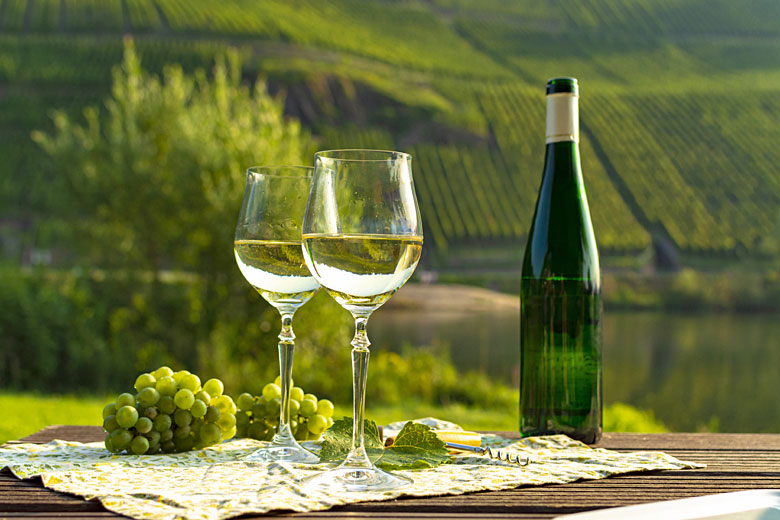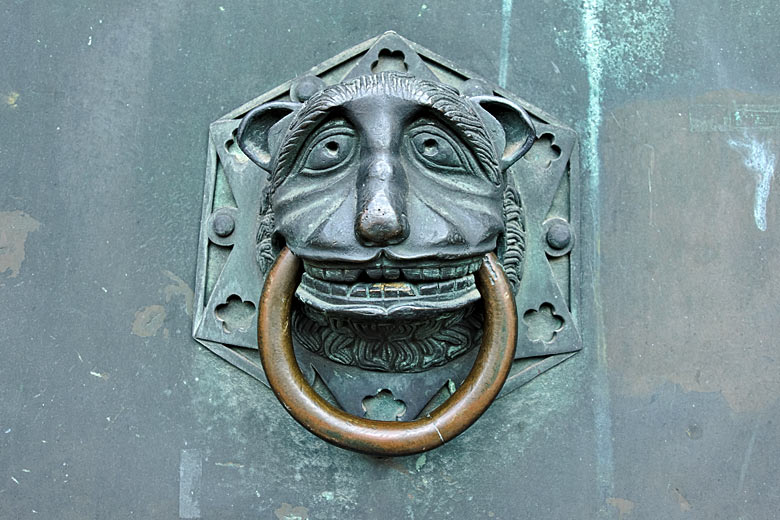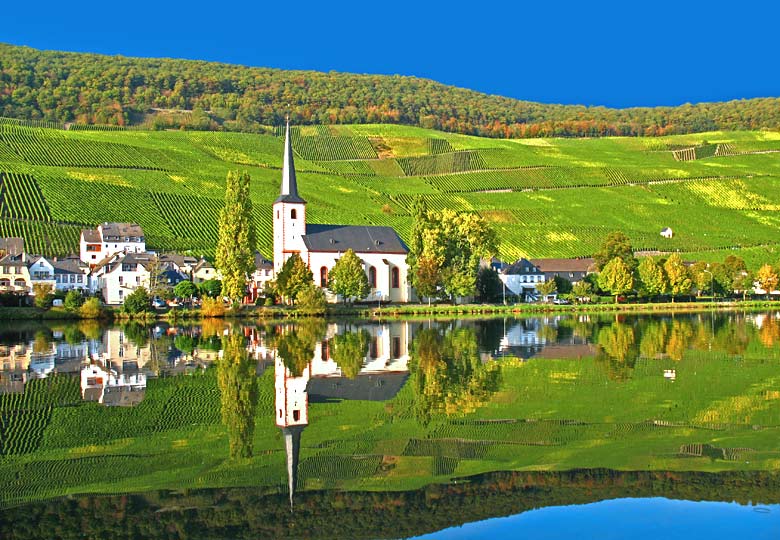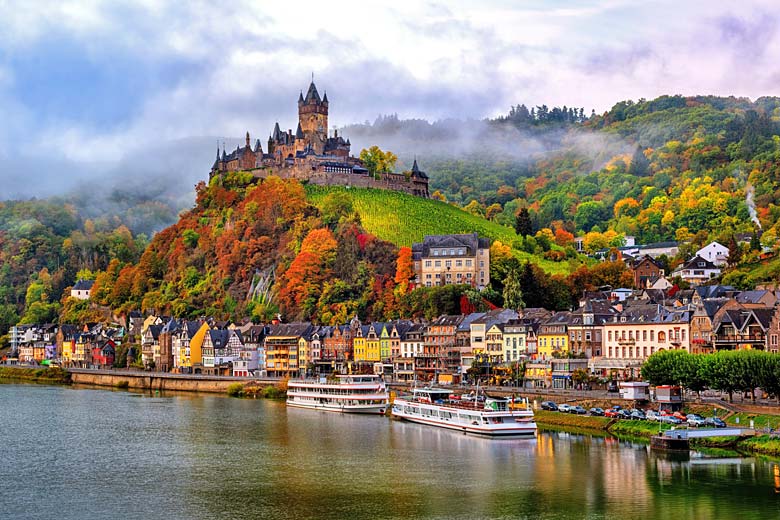The meandering Moselle: a tour through Germany's winelands
Mention the Moselle and it's wine, world-famous wine, that springs to mind. Here, the verdant, steep slopes are carpeted in vines that produce simply delicious wines.

The region owes its enduring viticulture to the Romans, who planted vines along the banks here as far back as the first 2nd century. This tributary of the Rhine is bathed in history - and not just Roman remnants; the likes of the Celts and more modern man have left their indelible imprints as well.
Much like the Rhine, we're talking deeply historic towns and villages alive with half-timbered houses and tightly packed streets. That these little oases are awash with wine taverns and little inns makes the scene all the more appealing.
Getting to the Moselle: for a relaxing cruise through Germany's winelands, check out the latest offers on breaks with TUI River Cruises*.
While you could, of course, just idle aboard and take in this glorious part of the world from the deck, we strongly suggest that you get off at a few of the following temping ports of call.
Trier
If Trier* was any closer to Luxembourg it would be in the tiny state. Handily, a trip to one of the world's smallest countries and its clifftop capital is an easy excursion from German Trier.
Back in Trier itself, a great way of getting to grips with this compact centre is with a walking tour. This is an exciting experience as you're walking with the ghosts of the Romans, who are said to have set up shop here as early as 16 BC.

In true Roman form, they left behind what are arguably the finest Roman remnants in northern Europe - highlights include the experience of walking through a 2nd-century Roman city gate, the Porta Nigra, and a 20,000-seat amphitheatre that dates from 100 AD.
This antiquity comes as no surprise as Trier is thought to be Germany's oldest city and one that is easily navigable on foot for independent explorers looking to drift back through the centuries.
The Roemer-Express tourist train also skips around the main sights such as the City Museum and St Peter's Cathedral, which is reputed to be the oldest in all of Germany.
Piesport
You learn a lot about the town of Piesport* from its surroundings on the lifeblood River Moselle. It lies roughly halfway between Trier and Bernkastel-Kues and the slopes that crowd the river are awash with wine.
That's exactly what Piesport is renowned for as it's the largest wine-growing area in the Moselle Region. Perhaps the most famous name of all is the Goldtropfchen Estate, which translates as 'golden droplet', reflecting the colour and quality of the local wines.

It's said that the Romans cultivated wine here back in the 2nd century. Today the most famous wines are known as Piesporter, best experienced on a visit to a local winery. Make sure you also check out the baroque Church of St Michael, with its elegant ceilings.
For a more in-depth look at the Piesport, take a hike along the local walking trail, which features 23 different info points detailing an intriguing collage of fountains, churches and other sights.
Bernkastel-Kues
You get two destinations for the price of one in Bernkastel-Kues*, which sits on a serpentine bend in the River Moselle. Of the two settlements, Bernkastel is the star, the sort of pretty half-timbered gem that you may well have come to Germany in search of. The buildings are often gloriously higgledy-piggledy, boasting bags of atmosphere.
In some ways this area evokes parts of England with its rolling hills, little churches and tight streets. A single bridge is all that connects these two former rivals, which joined forces at the turn of the 20th century.
Kues is more modern, but worth nipping over to, especially as the local hostelries tend to be easier on the wallet than in its sibling. Saying that it's hard to beat the romance of a wine tavern set in one of the atmospheric houses.
Take a tour that incorporates the twin-town history and the local landmarks. You won't forget the unlikely Spitzhaeuschen, the precarious-looking 'pointed house' in a hurry, which dates way back to 1416, nor Landshut Castle, which gazes out over the Moselle. Also included in the tour is the Graacher Gate - the Bernkastel-Kues gateway.
Traben-Trarbach
The largest town on the middle Moselle is a great place to come if you like wine - and lots of it as there's a flurry of local producers. Indeed, Traben-Trarbach* used to be one of the largest exporters of wine in Europe with Riesling the star grape.
Until fairly recently, the lifeblood grape had fallen out of favour, but today it is again peaking in popularity. The vineyards are charmingly set on the slopes on either bank of the river. It's not just wine, though, that hides below the streets of the town in vast cellars.
Thermal waters run deep too and the town has a long history as a spa destination. It's no slouch on the eye-catching stakes either with art nouveau buildings weaving their ornate way around the streets, while the ruins of Grevenburg Castle oversee the scene.
Cochem
It's time to get the camera at the ready as you approach charming Cochem*. More of those beam-supported houses in pastel hues line the waterfront, while rugged green slopes in the background soar up towards the landmark castle.
This is picturebook Germany. As early as Roman and Celtic times man has appreciated the remarkable riverside setting. Today, you can enjoy the pleasure of easing through the ages around its narrow streets, through its medieval gates and underneath its welter of gorgeous houses.

Many of those old buildings now house cosy wee cafés, pubs and restaurants. If you want to take it all in, you should make a beeline for the chairlift that zooms you up to the Pinnerkreuz Lookout for an epic view. You'll see the Reichsburg Castle from here, too.
You can wander it on your own or book a city and castle tour, which kicks off with a drive up to the castle, whose history sweeps back over 800 years, though what you see today is largely a late 19th-century recreation.
The interior is as impressive as the exterior, a real riot of Renaissance and Baroque-style furniture. Enjoy the views back to the town before easing down into the old streets for a guided tour of the architecture and the 500-year-old Church of St Martin.
A cerebral attraction awaits on the way back to the ship at the 17th-century Capuchin Monastery, which now functions as a cultural centre. One unusual Cochem attraction is the old Cold War bunker. This 'secret' is said to have once stored £8 billion of Germany's Central Bank's cash to keep it safe in the event of a nuclear war.
Weather in the Moselle region
| Jan | Feb | Mar | Apr | May | Jun | Jul | Aug | Sep | Oct | Nov | Dec | |
|---|---|---|---|---|---|---|---|---|---|---|---|---|
| Maximum daytime temperature °C |  3 3 |
 5 5 |
 9 9 |
 13 13 |
 18 18 |
 21 21 |
 23 23 |
 22 22 |
 19 19 |
 14 14 |
 7 7 |
 4 4 |
| Hours of sunshine (daily) | ||||||||||||
| Days with some rainfall |  18 18 |
 15 15 |
 17 17 |
 15 15 |
 16 16 |
 15 15 |
 13 13 |
 13 13 |
 13 13 |
 15 15 |
 17 17 |
 17 17 |
Fancy meandering along the Moselle? Check out the current deals on itineraries with TUI River Cruises, which offers an adults-only sojourn on some of Europe's most scenic waterways.
Be inspired
Get your weekly fix of holiday inspiration from some of the world's best travel writers plus save on your next trip with the latest exclusive offers
We promise not to share your details
Explore holidays in the sun for less
- Beach holidays
- Family holidays
- City breaks
- Summer holidays
- Winter sun holidays
- Holiday offers
- Top travel brands
- Airlines & flights
- Discount hotels
- Airport parking deals
- TUI
- Jet2holidays
- easyJet holidays
- Love Holidays
- January sales
Airport parking
- Manchester Airport
- Stansted Airport
- Bristol Airport
- Luton Airport
- Birmingham Airport
- Edinburgh Airport
- Gatwick Airport
- Glasgow Airport
- Newcastle Airport
Airport lounges
- Manchester Airport
- Birmingham Airport
- Bristol Airport
- Edinburgh Airport
- Glasgow Airport
- Heathrow Airport
- Newcastle Airport
- Stansted Airport
- Gatwick Airport










